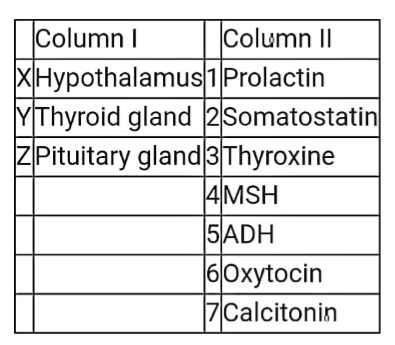Describe various endorine glands.
Step-by-Step Solution:
1. Definition of Endocrine Glands:
- Endocrine glands are specialized glands in the body that secrete hormones directly into the bloodstream. They are also known as ductless glands because they do not have ducts to carry their secretions. Instead, hormones are transported through the blood to target organs or tissues.
2. Hypothalamus:
- The hypothalamus is located in the brain and plays a crucial role in regulating the endocrine system. It releases hormones known as releasing hormones, which stimulate the pituitary gland to release its hormones.
3. Pituitary Gland:
- Often referred to as the "master gland," the pituitary gland is controlled by the hypothalamus. It has two parts:
- Anterior Pituitary: This part releases several important hormones, including the growth hormone, which is essential for body growth.
- Posterior Pituitary: This part releases hormones such as Antidiuretic Hormone (ADH), which helps in water balance, and Oxytocin, known as the "birth hormone," which aids in childbirth by contracting the uterus.
4. Thyroid Gland:
- The thyroid gland is located in the neck and produces the hormone thyroxine. Iodine is essential for the production of thyroxine, which regulates the basal metabolic rate (BMR) in the body.
5. Adrenal Gland:
- The adrenal glands are located on top of the kidneys. They secrete hormones known as stress hormones, with adrenaline being a key example. Adrenaline is released in response to stress or fear, preparing the body for a "fight or flight" response.
6. Gonads:
- Gonads refer to the reproductive glands, which differ in males and females:
- Testes: The male gonads produce testosterone, which is responsible for male secondary sexual characteristics and reproductive functions.
- Ovaries: The female gonads produce two main hormones: estrogen and progesterone, which regulate female reproductive functions and secondary sexual characteristics.
Summary of Endocrine Glands:
- Hypothalamus: Releases releasing hormones.
- Pituitary Gland: Master gland; releases growth hormone, ADH, and oxytocin.
- Thyroid Gland: Produces thyroxine; requires iodine.
- Adrenal Gland: Secretes stress hormones like adrenaline.
- Gonads: Testes (testosterone) in males and ovaries (estrogen and progesterone) in females.
- Endocrine glands are specialized glands in the body that secrete hormones directly into the bloodstream. They are also known as ductless glands because they do not have ducts to carry their secretions. Instead, hormones are transported through the blood to target organs or tissues.
- The hypothalamus is located in the brain and plays a crucial role in regulating the endocrine system. It releases hormones known as releasing hormones, which stimulate the pituitary gland to release its hormones.
- Often referred to as the "master gland," the pituitary gland is controlled by the hypothalamus. It has two parts:
- Anterior Pituitary: This part releases several important hormones, including the growth hormone, which is essential for body growth.
- Posterior Pituitary: This part releases hormones such as Antidiuretic Hormone (ADH), which helps in water balance, and Oxytocin, known as the "birth hormone," which aids in childbirth by contracting the uterus.
- The thyroid gland is located in the neck and produces the hormone thyroxine. Iodine is essential for the production of thyroxine, which regulates the basal metabolic rate (BMR) in the body.
- The adrenal glands are located on top of the kidneys. They secrete hormones known as stress hormones, with adrenaline being a key example. Adrenaline is released in response to stress or fear, preparing the body for a "fight or flight" response.
- Gonads refer to the reproductive glands, which differ in males and females:
- Testes: The male gonads produce testosterone, which is responsible for male secondary sexual characteristics and reproductive functions.
- Ovaries: The female gonads produce two main hormones: estrogen and progesterone, which regulate female reproductive functions and secondary sexual characteristics.
- Hypothalamus: Releases releasing hormones.
- Pituitary Gland: Master gland; releases growth hormone, ADH, and oxytocin.
- Thyroid Gland: Produces thyroxine; requires iodine.
- Adrenal Gland: Secretes stress hormones like adrenaline.
- Gonads: Testes (testosterone) in males and ovaries (estrogen and progesterone) in females.
Topper's Solved these Questions
Similar Questions
What is the name of in-built 'arrangement' in our body which controls the timing and amount of hormones released by various endocrine glands in the body?
View SolutionMany hormones are released from various endocrine glands of the body. Match the endocrine glands with the product hormones.
 View Solution
View SolutionStudy the given figure carefully and answer the following questions :

(i) Label the various endocrine glands marked as (a), (b), (c ), (d), (e ), (f), (g),(h),(i) and (j).
(ii) Given hormone secretions of each of these glands.View SolutionDiagrammatically indicate the location of the various endocrine glands in our body .
View SolutionDescribe various categories of dieases.
View SolutionDescribe various events in human embryonic development at various months of pregnancy
View SolutionDescribe various Intra-Uterine Devices
View SolutionDescribe various methods of asexual reproduction in algae.
View SolutionDescribe various steps of cleaning wastewater in a wastewater treatment plant.
View SolutionDescribe various contrasting traits studied by Mendel in pea plants
View Solution

